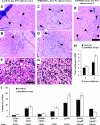Exacerbated pathology of viral encephalitis in mice with central nervous system-specific autoantibodies
- PMID: 17255324
- PMCID: PMC1851853
- DOI: 10.2353/ajpath.2007.060893
Exacerbated pathology of viral encephalitis in mice with central nervous system-specific autoantibodies
Abstract
We examine here the outcome of viral encephalomyelitis [mouse hepatitis virus (MHV) A59, Theiler's encephalomyelitis virus, and Coxsackievirus B3] in mice with autoantibodies to a central nervous system (CNS)-specific antigen, myelin oligodendrocyte glycoprotein, that usually develop no clinical disease. Morbidity and mortality of the acute viral CNS disease was augmented by the presence of the autoantibodies in all three viral infections. Transfer of serum containing the autoantibodies at the time of infection with MHV was sufficient to reproduce the exacerbated disease. The presence of the autoantibodies was found to result in increased infiltration of mononuclear cells into the brain. Early demyelination was severely augmented in brains and spinal cords of MHV-infected mice with CNS-specific autoantibodies. The antibody-mediated exacerbation was shown to be independent of the complement system but to require expression of Fc receptors, because it was observed in C'-3-deficient but not in Fc receptor-deficient mice. Our study illustrates the possibility that infections can lead to much more profound immunopathology in the presence of an otherwise latent autoimmune condition.
Figures






Comment in
-
Anti-viral T-cell immunity+anti-CNS autoantibody=a model for human acute disseminated encephalomyelitis or multiple sclerosis relapse?Am J Pathol. 2007 Feb;170(2):436-8. doi: 10.2353/ajpath.2007.061098. Am J Pathol. 2007. PMID: 17255311 Free PMC article. No abstract available.
References
-
- von Herrath MG, Fujinami RS, Whitton JL. Microorganisms and autoimmunity: making the barren field fertile? Nat Rev Microbiol. 2003;1:151–157. - PubMed
-
- Panoutsakopoulou V, Sanchirico ME, Huster KM, Jansson M, Granucci F, Shim DJ, Wucherpfennig KW, Cantor H. Analysis of the relationship between viral infection and autoimmune disease. Immunity. 2001;15:137–147. - PubMed
-
- McCoy L, Tsunoda I, Fujinami RS. Multiple sclerosis and virus induced immune responses: autoimmunity can be primed by molecular mimicry and augmented by bystander activation. Autoimmunity. 2006;39:9–19. - PubMed
-
- Buljevac D, Flach HZ, Hop WC, Hijdra D, Laman JD, Savelkoul HF, van Der Meche FG, van Doorn PA, Hintzen RQ. Prospective study on the relationship between infections and multiple sclerosis exacerbations. Brain. 2002;125:952–960. - PubMed
Publication types
MeSH terms
Substances
Grants and funding
LinkOut - more resources
Full Text Sources
Medical
Molecular Biology Databases

